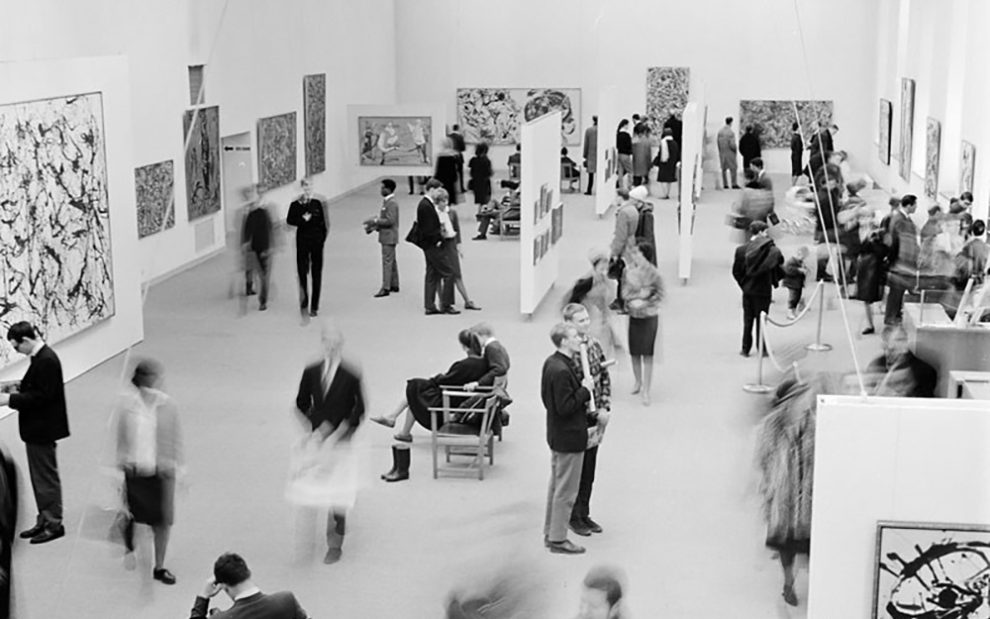I was 20 when I first felt that God might be calling a baptized Episcopalian to join the Catholic Church, but it would be more than 10 years later before I recognized the unmistakable sign he put in my path, the one that left me no choice but to start adult confirmation classes. In the intervening years, though, Jackson Pollock taught me how to pray.
At the risk of shortchanging both his own evolution and the contributions of other artists, Jackson Pollock is widely considered one of the most important figures in American Abstract Expressionism, the artistic movement instrumental in moving the center of the art world from European capitals, like Paris and London, to New York City. Other Abstract Expressionists include Willem De Kooning, Joan Mitchell, Mark Rothko, and Lee Krasner. Pollock’s most famous method is sometimes called action painting; he would famously stalk around and across a large canvas, laid on the floor, and drip, splash, and scatter the paint across it, taking abstraction out of the largely intellectual realm where it had existed before and turning it into something like pure expression. It is my good fortune to live near the National Gallery of Art in Washington, DC, a museum with several of his works, including the one known as Lavender Mist, a monumental canvas painted in his signature style.
During a period of extended renovations, the museum moved Lavender Mist from its usual spot in the white cube walls of the East Building to an earth-toned and wood-paneled underground hallway in the museum’s West Building, and it felt like my church had been boarded up and services moved to a community center basement. The lighting was better than the fluorescent bulbs of that hypothetical basement, but the sense of loss was very real.
No. 1, 1950 (Lavender Mist) is, in my biased opinion, the culmination of Pollock’s best-known style and, as I write this, properly back in the refurbished East Building of the National Gallery of Art, dominating a room filled with works by the giants of American Abstract Expressionism (dominating, in part through size; it shares the room with masterpieces by artists like Joan Mitchell, Lee Krasner, and Mark Rothko). Over seven feet tall and nearly 10 feet wide, it is slashing vortex of blacks, silvers, whites, pinks, and blues that form layered webs across every inch of the canvas.
Art has always held a central place in prayer practices and helped us connect with God. At Mass, I read the psalms, King David’s love poems to God; I listen to hymns extolling the glory of the Lord; and I look up to a more than life-sized crucifix hanging above the altar. In quieter moments, I kneel before for a statue of Mary or follow the story of the Stations of the Cross. Of course, these are not examples of abstract art, but I am not the first to connect Abstract Expressionism, in particular, with the prayer.
Soon, I will visit the University of St. Thomas in Houston for a residency, and I won’t be dragged away from that city until I have visited its Rothko Chapel. The Phillips Collection, a private museum in DC, has a small room of paintings by the Abstract Expressionist Mark Rothko that is clearly inspired by the chapel; just entering the room causes all but the noisiest of small children and most insensitive of adults to quiet themselves. The structure in Houston, though an interfaith space not affiliated with any specific religion, is very deliberately called a chapel. My own impression, from a distance, is that it is not intended to be “spiritual, but not religious,” but an intentional space for religious contemplation and prayer and the paintings (which are almost purely abstract, though engaging with form in way that Lavender Mist does not), like the statue of Our Lady I visit on Sundays, provide an aid to silent prayer.
Despite being viscerally more frenetic than a Rothko or, really, any artwork I have ever seen, this Pollock draws me closer to what I now recognize as prayer than does a meditative Rothko or even a medieval Pietà. It is expansive and has an infinite number of centers to draw the gaze. To meditate on it, I must either choose a place within it or else implicitly acknowledge that there is an infinity to contemplate that will always be beyond me.
In Matthew 3:17 in the King James Bible version, upon which I was fed as a youth, God speaks from heaven and says, “This is my beloved son, in whom I am well pleased.” As a father, this always helps me to understand something about the Lord. He is God the Father, because God is a father, and even though his immensity is beyond us, he is also a loving parent who takes joy and pride in his child. But there are other sides to God, and there is the aspect that is the opposite of the relatable parent. The side that is incomprehensible to humanity on earth.
Credo qui absurdum, I believe because it is absurd.
That famed Latin phrase is a mistranslation and a misunderstanding of Tertullian (a perfectly rational church father), but it can also grow to have its own meaning, free from easy mockery. It can grow into an expression of the absurdity of trying to make rational sense of God or creation—or of Lavender Mist—from our limited perspectives, because important truths about them will always remain beyond us, at least as long as we are here in the world. Our all-encompassing theories and schema are doomed to be either patently reductive or pointlessly inadequate. We are driven to faith because there is no place else where we can complete the meaning we seek. Once I found myself there, I was also within the painting’s meaning, notwithstanding that rational understanding still eluded me, because I learned to exist within it, without a purely rational meaning that I could put down here, on paper, for you. This does not preclude all rational comprehension, but it does mean an understanding achieved through extended contemplation; and only faith in the possibilities emerging from this contemplation allowed me to sit with it for extended lengths of time.
And sit with it, I did. Before my child came into my world (and she has also been invaluable in learning new lessons from contemplation of God and Lavender Mist) and my weekends were more my own, this work was an important refuge for me. Like a close viewing of the Eucharistic Rite over time, it went from enthralling to a sort of rote vagueness and then finally to something new. Not new again, because this was a different newness to those first encounters. Instead of novelty, there was an acceptance of the intrinsic failure of sight and the limitations of the senses, entirely.
When I became a Catholic, I tried many types of prayer and struggled with it. I lacked patience, and my mind wandered to topics beneath the spirit: work, sex, politics. As someone who best understands things via the written word, I tried lectio divina, but mostly succeeded in turning it into an intellectual exercise.
My problem was that I was looking for answers. There is nothing wrong with seeking answers, but it can be limiting. It is not always helpful to approach God with questions, thoughts, and concerns and, however hard I tried, I could not set them aside and open myself up to God without expectation.
Then, one day, I went back to Lavender Mist. A single look at the canvas reminded me that I would not find in it intelligible answers about how to be creative, how to be a good parent, or why things were not working out the way I had hoped. The painting, like the prayer I needed, offered an encounter with something ineffable. I sat in front of my favorite painting and submerged my mind into its core incomprehensibility and spiritual potentialities and realized that I could pray—and pray at length—after all.
Art can be a tool for focusing our mind on spiritual things, and that is most often how we encounter the spiritual through art, via a direct connection between an image or verse and some part of the history or teachings of the church. But there are times when it is important not to focus or even seek clear, rational understanding. It is during those times that works like Lavender Mist have allowed me to encounter God on different terms and hear his voice in unexpected ways.
Image: Exhibition with Jackson Pollock’s paintings at Moderna Museet. Herbert Lindgren, 1963. The City Museum in Stockholm. (CC-BY 4.0)













Add comment